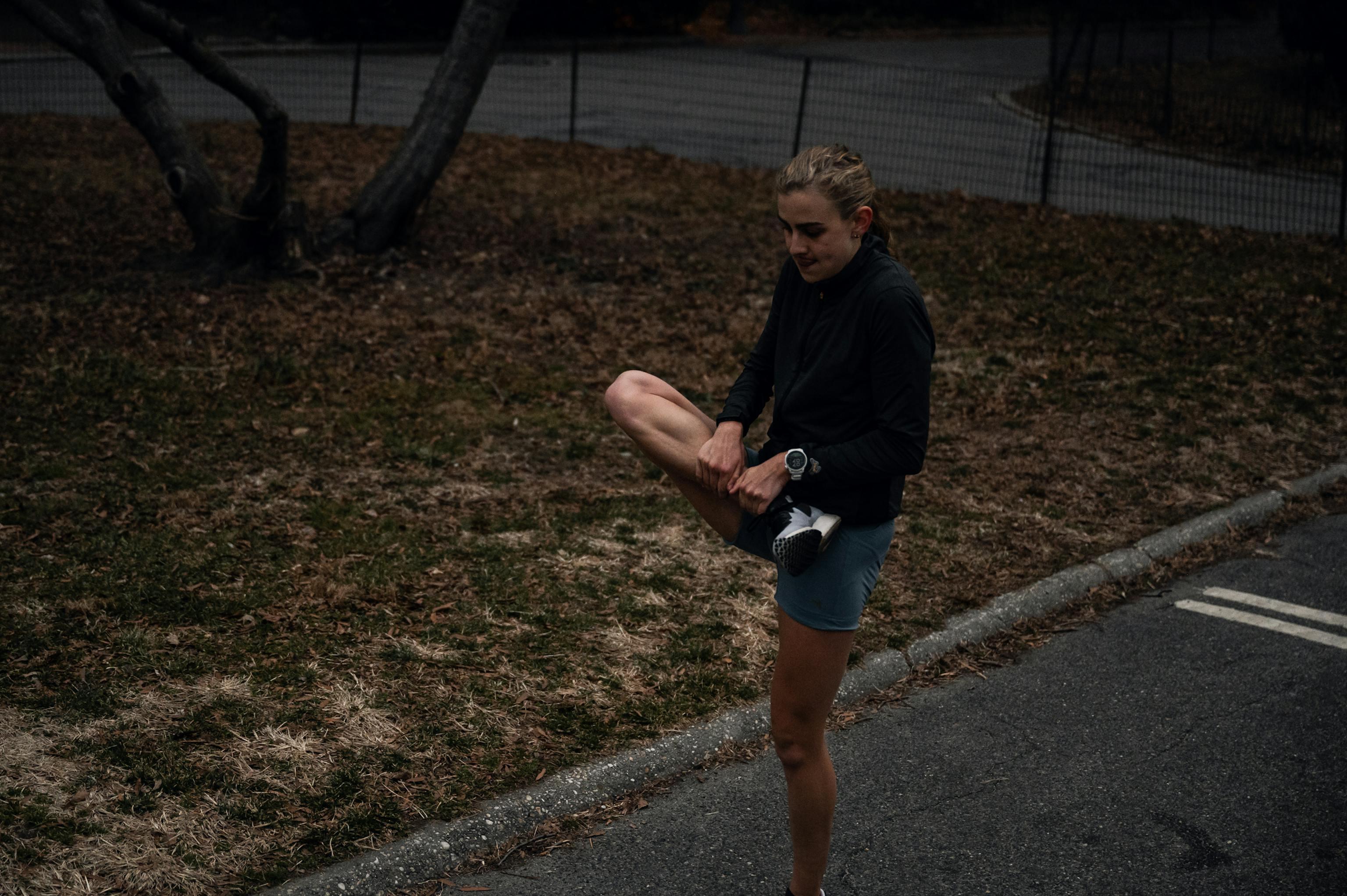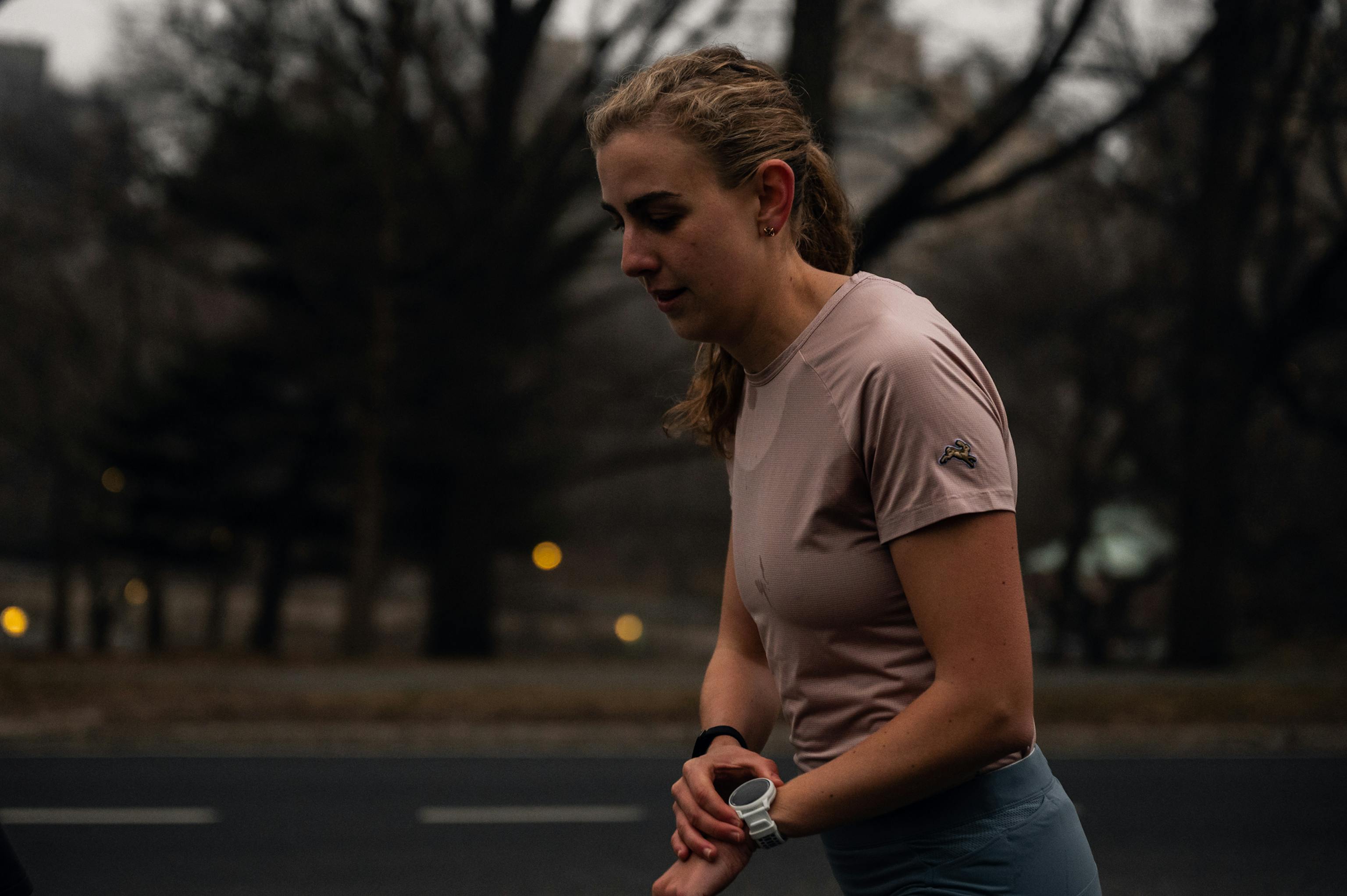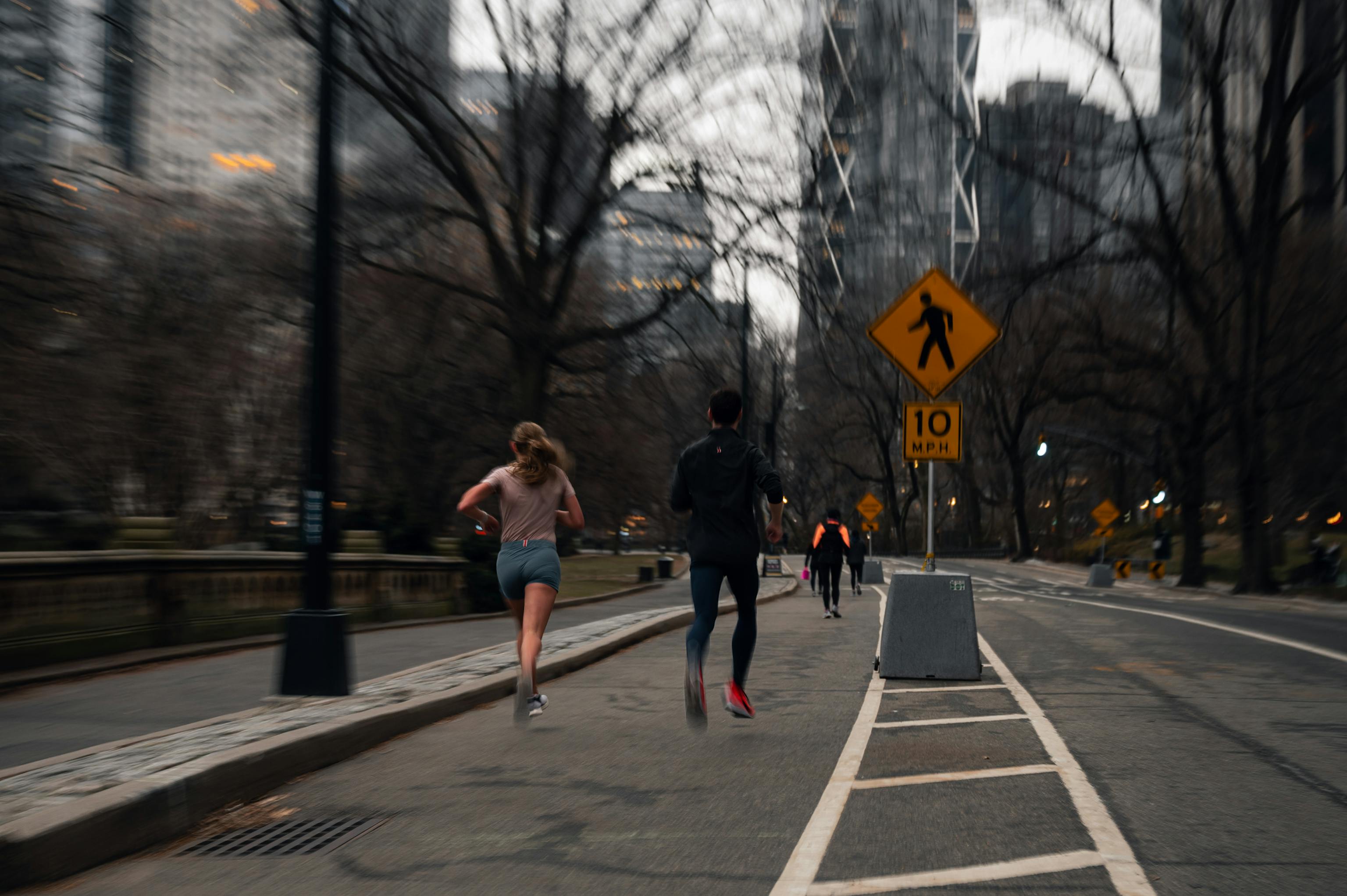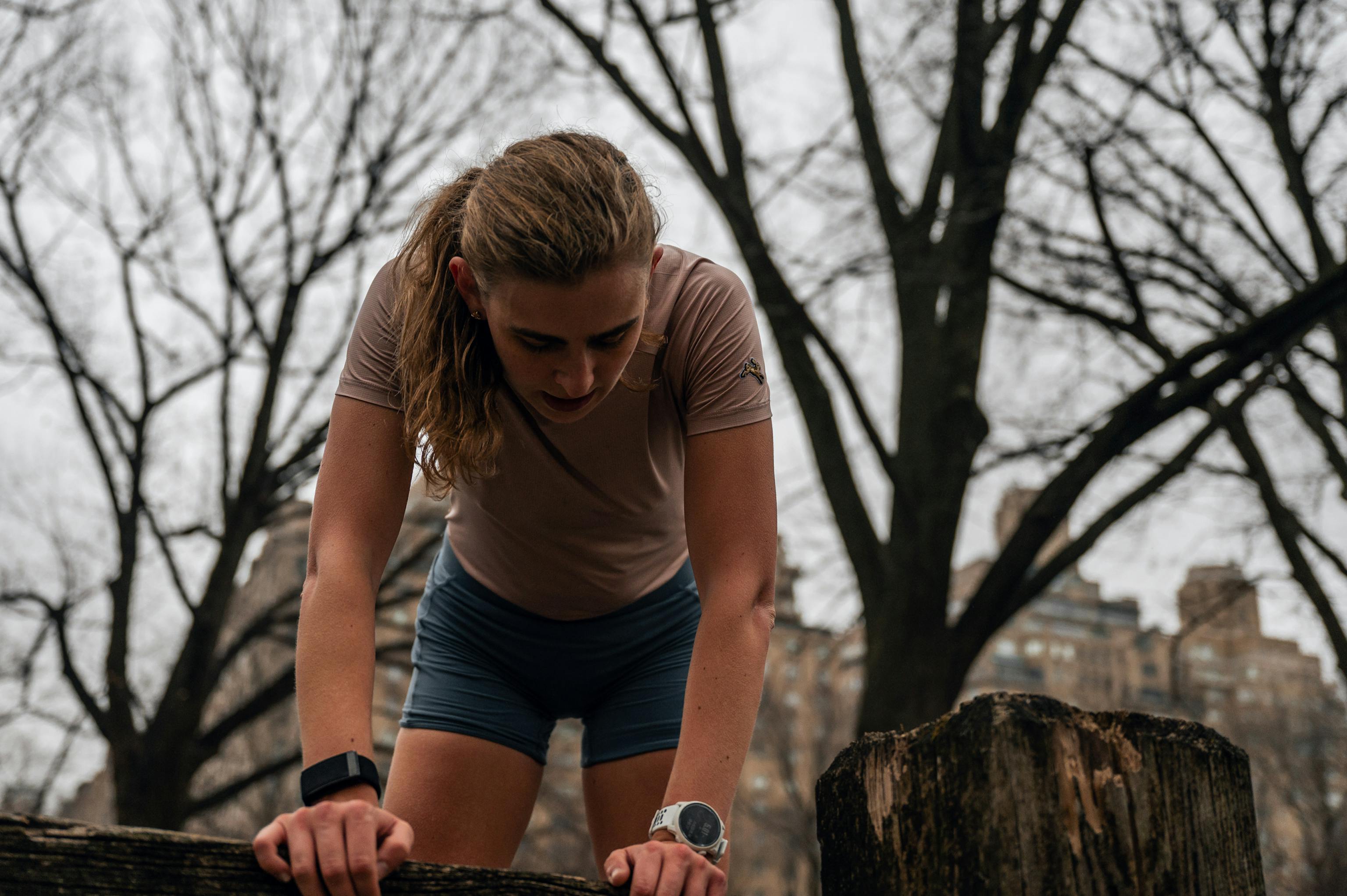
The Comeback Trail
From Surgery to
a Central Park TT
Words by Mary Cain
Photography by Johnny Zhang
I knew something was off. 2020 indoors had been my first healthy racing season in three years, but as soon as it finished, I started feeling some discomfort in my left hip. That meant shutting down running for a week after the Trials were canceled and looking forward to summer training. One week off seemed like it might do the trick. From the beginning of April to the beginning of July, I got three months of training in and started to think about my options for stringing some sort of season together. Maybe a virtual race? Time trial? There was no pressure to perform, but I was excited by my workouts and thought racing would be fun. Yes, my left hip still felt a bit “off” but I figured it was fine. Then my right hip flared up.
It was a strange feeling. During one workout, I just noticed my hip felt wrong. It was like my proprioception wasn’t kicking in. By the next day, it hurt… a lot. And the left hip was once again hurting. Maybe the lack of access to massage meant my muscles were getting tight? Massage treatments didn’t seem to help though, so I took some time off. Aqua-jogging for a week didn’t seem to do the trick either, so I finally did the one thing I never recommend: I Dr. Googled myself.
On a Sunday afternoon after too much online research, I emailed my doctor, Dr. Lynch at Columbia University, and explained my symptoms and self-diagnosis. Things happened quickly. After reading my note, he booked me for an appointment that very Friday, and I got the appropriate diagnostic images during the days before. And on Friday, July 24th, Dr. Lynch confirmed what I already knew.
I had hip impingement, also known as femoroacetabular impingement (FAI). Hip impingement occurs when bony abnormalities of either the femoral head or the acetabulum (in my case, both) result in too much friction in the joint. My pain was from the internal wear-and-tear causing my labrums to tear in both of my hips. Exactly one week after the official diagnosis, I went in for bilateral hip arthroscopic surgery.

Despite many past bone injuries, the comeback from surgery was the most intensive rehab process I have ever been through. But the truth is, this has been by far the best rehab process I have been through too. Why, you may ask? Because I fully leaned in. After years of trial and error, I have learned to truly listen to my doctors, nutritionist, PT, and coaches. That may sound silly, but it’s so easy to think we know better. For example, I was on crutches for six weeks after surgery. But, after one week, I felt pretty good. By four weeks, I was questioning why I couldn't run yet, let alone bike more, but I listened to my support team and didn’t do a step more than I was supposed to.
I am not a medical professional, so for anyone currently experiencing their own rehab journey, make sure to work with your doctor to create the best plan for you. But to give you some context, inspiration, and hope, I’m laying out my own general monthly training breakdown that brought me from surgery to a five-mile time trial in Central Park. The day-to-day progress at times seemed frustratingly slow, but before I knew it, I was running. And then suddenly doing workouts. And then - boom! - time trial time. There’s so much more work left to be done, but with patience, perseverance and steady progress, I know I'll get where I need to be.
August: I stayed at my parents’ house for the 10-day postoperative period. I am incredibly lucky to have had that support. I was walking on two crutches and fully weight-bearing, but the immediate post-op period is uncomfortable. I had my surgery on a Friday, and that first weekend I was minimally mobile (special shoutout to my mom for helping me get around, get into my ice machine, mobilize my legs, and get food). That Monday, I started PT and also logged back into work (the perfect distraction). From then on, I went to PT twice a week and slowly started to build up exercises. I was able to start spinning soon after surgery, but the load was not meant to build fitness, just generate movement. So every other day I added two additional minutes of spin time until I hit 25 minutes, and then I would drop back to 20 minutes and add extra resistance. Slow and steady wins the race. I had daily homework (which I followed diligently), which we added to each session. All of the exercises were movement or recovery-based.

September: Over the course of four weeks, or eight PT sessions, I suddenly had a decently long list of exercises I was doing every day (15-20) as well as spinning 20-25 minutes per day. At the beginning of the month, we started going for walks with my crutches. Every day, I tried to walk a little bit farther. Halfway through the month, I was able to gradually work my way from two crutches to one to none. I also added some new cross-training into my schedule. I started with pool work (the progression was movement exercises to pool running (in the shallow end) to aqua jogging to swimming). Each day, the additional exercise was minimal (like one more rep or two more minutes), but over the course of a month it added up significantly. By the end of the month, I felt like I was genuinely cross-training (the addition of pogo jumps was probably that turning point in mindset).
October: All in all, I took 12 weeks off from running. In early October, I begin the slow transition to running. I continued with slowly progressing my cross-training load, and began adding running training every-other-day. I started on the AlterG and began building my load of 1min on, 1min off of running. Each session, I increased the time on my feet before dropping the cumulative time and adding weight. Near the middle of October, I transitioned from the AlterG to the treadmill or 100 per cent body weight. I started with 10 x 1min on, 1min off, and each session added a little bit more. I kept my runs inside since there were fewer variables at play when on a treadmill.
November: My first run outside was on November 7th. I did 12 x 1min on, 1min off. I ran around the great lawn of Central Park and remember smiling the whole run. I began to add in extra runs (I went from three to five runs per week over the course of the month). I also kept increasing the amount of time between walk breaks. So between my first run in November and my last, I went from 12 x 1min on, 1min off, to 2 x 25min on with 2min off. That sounds like a big jump, but the day-to-day progression was slow and purposeful.
December: I finally began doing non-stop runs. I was still cross-training one or two days per week and progressively increasing my strength training load. My runs started within 40-50 minutes and each week I added five or so minutes to each run. My weekly mileage went from 34 to 54 by adding one extra run each week and slowly increasing the time on my feet. Throughout the month, all of my runs were easy, base-building miles.

January: This is when I finally felt back up to speed. Over the course of the month, I ran between 55 mpw - 65 mpw (which is my sweet spot). I began running seven days a week and doing long runs of 12-14.5 miles. This was important because it meant I started joining my coach’s weekly long run crew on Sundays, which was really special. The most important change to my training, though, was adding in twice-weekly workouts. Every Tuesday and Friday, I went to Central Park to do some faster work. I took my progression in pace slowly. We started with time-based running (reps of 1min hard, 1min float) and slowly built into doing stronger, longer reps. This was my month of introducing my body back to faster paces.
February: I was fully in the flow. At this point, I was doing strong workouts, accumulating mileage, lifting heavier, and doing classic base-building training. I boosted my mileage up a bit to the mid-70s, but couldn’t believe how much better my hips were moving. They were the best they’d ever been. I knew this because I began integrating more drill work into my training (this really picked up in March, but February was my transition into drills). Most notably, I used to not be able to lift my knees high during A-skips or high knees, but I was suddenly finding myself powering my hips to raise my knees well past 90 degrees. Up until this point, I had never been able to do that smoothly (aka I’d either have to actively pull my knee in with my hands or arch my back to get enough leverage). We could also see the improvements visibly in each PT session. Where I once felt restriction or pinching bringing my hips through a full range of motion, I now was much more comfortable. This definitely was a relief, since you always have to wonder mid-recovery when you will see such gains, and it was exciting to finally live it.

March: I finally hit the track again. This month was meant to be when I transitioned to speedier work and kept my mileage strong. We decided to test my fitness in a five-mile time trial, which is totally outside of my comfort zone. Total transparency: I was pretty disappointed in my run. Sciatica-symptoms flared up the week of my run and I felt strong for the first three miles but started to feel off for the final two. Afterward, I felt so down. It felt like this time trial was meant to be both a beginning and an end; a beginning to track season and end to the comeback. So how, after all of this time, work, and effort, could something flare up?
With the start of a new month, I feel I now have an answer to that question. Pure and simple, it’s because things flare up in running. No one has a perfect build-up and between my surgery and three days before my time trial, training had been nearly perfect. When you lean in, sometimes you're going to stumble, and we’re bound to have days where we go over our own red lines. And those days aren’t about getting down, they’re about getting to the bottom of the problem, addressing it, and moving forward.

So that’s what I did. For the last few weeks, I decided to back off training intensity. I dropped mileage back to 60 and cut out speed workouts and just ran. I focused on addressing the flare-up. Now that I look to the start of April, I look forward to getting back to speedier work. I’ve learned some new lessons about my body, limits, and ability to persevere in all of the months from surgery. And I’ve finally learned the importance of listening to my body. It’s helped me get this far, and I trust it to keep carrying me over the many thousands of miles I have yet to go.
I’ve also learned the importance of listening to my doctors, coaches and support crew. I wanted to end this piece by thanking all those who helped me, are helping me, and will continue to support me in this running journey. I am grateful to my surgeon, Dr. Lynch, my PT, Vikash Sharma, my coach, John Henwood, my nutritionist, Lindsey Elizabeth Cortes, my boyfriend, Jake, and all of my family, friends, running buddies, and coworkers. A special thank you to the team at Tracksmith. The truth is, without their support, the recovery from this would have felt so much more daunting. I was worried my diagnosis would be met by disappointment in me, since that’s how my last relationship with a running company went. Instead, my coworkers rallied around me and cheered me on every step of the way. They’re here for me on the good days and the not-so-good, and for that I am beyond grateful. It makes me that much more excited for getting to lace up again both with and for my Tracksmith team.
